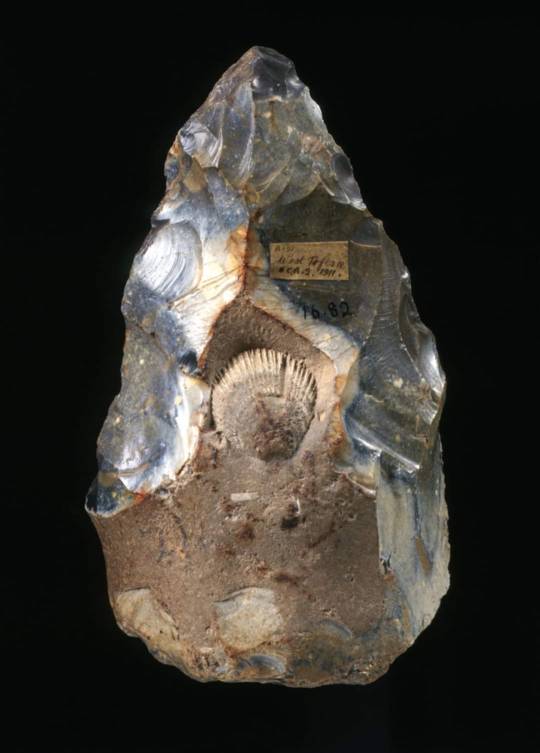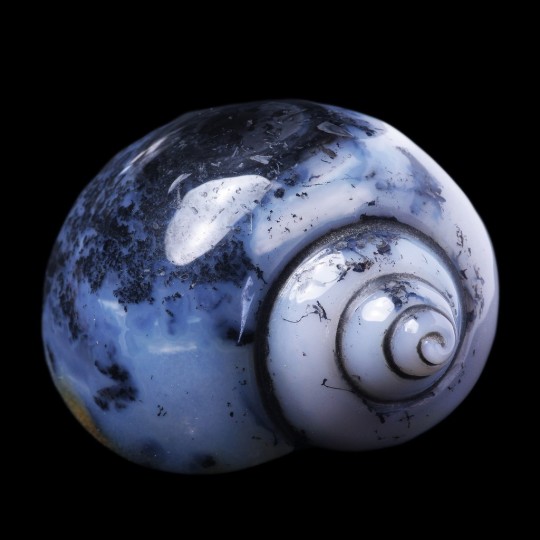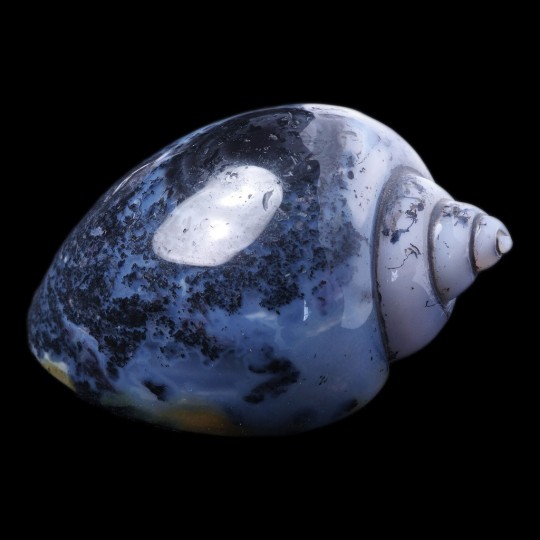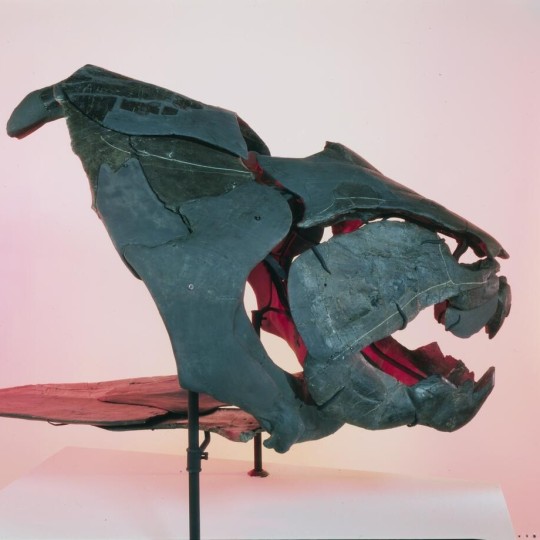Photo

Decorated pearl shell pendants from the Kimberley region, Western Australia. These have been incised with traditional Aboriginal as well as more contemporary designs, and filled in with red ochre. Via Ikat Nedej.
11 notes
·
View notes
Text

An extraordinary Acheulean handaxe knapped around a fossil shell circa 500,000-300,000 years ago.
The maker appears to have deliberately flaked around the shell to preserve and place it in a central position. As a result this handaxe has been described as an early example of artistic thought.
From West Tofts, Norfolk.
Museum of Archaeology and Anthropology, University of Cambridge, Courtesy Alison Fisk
25K notes
·
View notes
Text

Dragonfly fossil, 250-300 million years ago with 2 ft. wingspan.
5K notes
·
View notes
Photo




A piece of dinosaur tail, complete with attached feathers
Burmese amber is full of surprises, like the recently found wings from an early bird (see http://bit.ly/2hpvCQK), but this latest find from the Hukawng Valley in Kachin state really takes the biscuit: the first incontrovertible dinosaur feathers found in amber (though they have turned up before, without chunk of attached dino to put any potential scepticism to rest (see http://bit.ly/1DTZQdF and http://bit.ly/1QpTFac, as well as in some well preserved fossil saurians. The unique and incredible piece (already shaped for jewellery use) was purchased by a sharp eyed palaeontologist at a gem market in the country last year, ostensibly as a tuft of plant matter (the feathers) accompanying some fossilised ants.
Keep reading
545 notes
·
View notes
Text

It's time for Trilobite Tuesday! This 5-in- (12.7-cm-) Lochmanolenelluss, from Nevada, represents one of the earliest trilobites to appear in the primal seas. Examples of this genus have been found dating back more than half-a-billion years. The double set of spines on each side of its head are one of this Lower Cambrian species’ distinguishing characteristics.
848 notes
·
View notes
Text

This is the best-preserved dinosaur ever found.
The 112-million-year-old nodosaurus is so intact that it still retains its armor plates, skin patterns, and even traces of its original pigmentation.
Scientists believe the nodosaurus was swept into an ancient sea, where rapid mineralization preserved its features with stunning detail. Unlike typical fossils, which consist mostly of bones, this "dinosaur mummy" provides an unprecedented glimpse into what these prehistoric creatures actually looked like in life.
Now displayed at the Royal Tyrrell Museum, this nodosaurus fossil is regarded as one of the most significant paleontological finds in history. The level of preservation offers rare insights into dinosaur biology, evolution, and even coloration, helping researchers understand their physical characteristics in ways never before possible.
Learn more: https://en.wikipedia.org/wiki/Borealopelta
Source: Facebook
Wikipedia.org
0 notes
Photo

You are looking at an Ammonite Fossil skull. In India ammonite fossils are identified with the god Vishnu and are used in various ceremonies. The name Ammonite comes from the Greek ram-horn God called Ammon. Ammonites are the most widely known fossil; they are cephalopods and first appeared in the seas 415 million years ago. (Source)
13K notes
·
View notes
Photo



Rare Cretaceous Gastropod epigenized in Dendritic Agate - Betul, India
39K notes
·
View notes
Text

Welcome back to Trilobite Tuesday! Scientists think that trilobites first emerged in the Cambrian seas some 521 million years ago. Even their earliest forms—like this 4-in- (10.2-cm-) Elliptocephala from Nevada—were already highly advanced organisms, possessing hard outer shells, complex eyes, walking legs, as well as efficient respiratory and reproductive systems.
941 notes
·
View notes
Text

This agate has just been cut. One of the best agate shells ever found. It still needs a polish. Credit: Simon Livingrock
5K notes
·
View notes
Text

Don’t mess with this fish! For Fossil Friday, let’s meet Dunkleosteus terrelli. It lived some 360 million years ago during the Devonian. Scientists think it was one of the first large jawed vertebrates in the ocean and an aggressive predator. The razor-sharp edges of bones in its jaws served as cutters, and as they rubbed against each other, the opposing jaw blades acted like self-sharpening shears. These bones continued to grow as they were worn down by use.
This specimen, on display in the Museum’s Hall of Vertebrate Origins, was found in Ohio. Spot Dunkleosteus and other prehistoric animals at the Museum! Plan your visit.
Photo: Image no. ptc-5861 © AMNH Library
710 notes
·
View notes
Text

Welcome back to Trilobite Tuesday. The Walcott-Rust Quarry, of upstate New York, is renowned for producing some of the best-preserved Ordovician trilobites in the world. Abundant examples of at least 18 species of trilobites, most of which have been studied extensively, have been discovered at the site. This 1.5-in- (3.8-cm-) long Ceraurus pleurexanthemus is one of the quarry’s most well-known species.
659 notes
·
View notes
Text
🦇Museum Curator of Mammalogy Angelo Soto-Centeno shares updates from his recent expedition to Puerto Rico, where he and a team of local and international researchers led a paleontological excavation and bat diversity inventory. The aim of this work was to explore new locations to examine the present, or living, and past, or fossil, communities of bats and identify species that have become extinct in recent times.
They found three species of extinct bats that were lost in the last 4,000 to 1,600 years—including insectivore and nectarivore bats!
454 notes
·
View notes
Text

With Halloween right around the corner, we’ve got a “spooky” fossil for you! This mummified arctic ground squirrel was frozen into the permafrost some 20,000 years ago. Usually, only hard skeletal parts of an animal, such as bones or teeth, are preserved as fossils. But the dry, frozen conditions within permafrost “freeze-dried” the squirrel and prevented its skin from decaying!
Photo: © AMNH
486 notes
·
View notes
Text
Massive Arietites Ammonites in Natural Matrix with Custom Base from Nancy, France ☠️😵💫☠️
Nature is Art 🫠
#NorthernMaineMinerals
94 notes
·
View notes
Text

This Fossil Friday, meet the Museum’s mummified hadrosaur—one of the most complete pieces of Mesozoic dinosaur remains ever found! This fossil represents one of the greatest discoveries in the history of paleontology: a rare glimpse at the texture of dinosaur skin. Like the skin on modern birds’ feet, this duck-billed dinosaur’s skin was marked by bumps called tubercles. The tubercles are larger along the animal’s back and sides and smaller around the joints, which needed to be flexible.
Photo: Image no. ptc-7737 © / AMNH Library (Circa 1992)
2K notes
·
View notes
